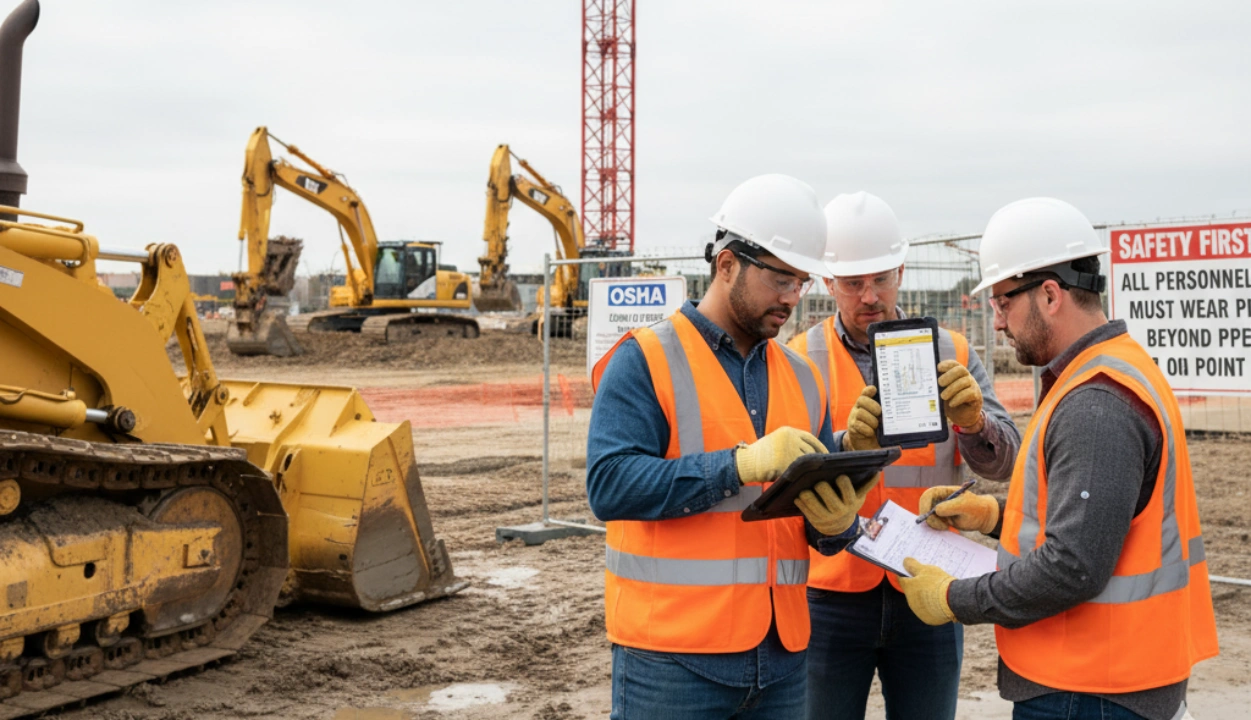Dashcam Installation Tips for Vehicles: A Detailed Guide
Dashcams have become essential for modern heavy equipment, offering enhanced security, accountability, and legal protection.
Whether they are used for recording accidents, preventing insurance fraud, or watching the site conditions these devices make one feel secure on every trip.
However, for many people, installation of a dashcam can seem rather challenging especially because of the possible technical challenges and the possibility of infringing local laws.
While professional installation is always an option, most dash cams can be successfully installed by the foreman with the right preparation and guidance.
Each vehicle model and dashcam system presents its unique requirements, meaning no two installations are identical.
This guide offers step-by-step advice for installing dashcams effectively, including tips on optimal placement, wiring solutions, system testing, and troubleshooting, ensuring a seamless setup and long-term reliability.
Essential Considerations Before Installation
1. Legal Considerations and Preparation
Legal Dashcam Placement Regulations

In the United States, dashcam placement laws vary by state. Some states permit mounting on the windshield as long as it doesn’t block the driver’s view, while others have stricter rules.
For instance:
- California allows dashcams in a 5-inch square on the upper center of the windshield or 7 inches in the lower corners.
- New York and Minnesota limit windshield-mounted cameras to specific areas behind the rearview mirror.
- Dashboard mounting is legal across most states and offers a safer option without obstructing the view or violating restrictions.
Drivers must also consider audio recording laws. California and other two-party consent states require you to inform passengers if the dashcam captures audio.
Insurance and Legal Benefits
Many insurance providers recognize the safety advantages that dashcams offer, with some offering discounted premiums for drivers who install them.
Even if a discount isn’t available, having a dashcam provides significant value in disputes by serving as first-hand evidence during accident investigations.
Such footage can help establish fault clearly and support insurance claims by demonstrating the events leading up to an accident in a way that removes ambiguity.
For dashcam videos to be admissible in insurance OR legal endeavors they need to be of specific quality.
Some insurers might insist on some of the attributes such as GPS for time stamping and location of incidence add more authenticity to the video clips.
Insurers also typically expect the recordings to be unedited and continuous, ensuring no critical moments are missing or altered.
Beyond assisting in standard accident claims, dashcams are highly effective in protecting drivers from fraudulent claims, such as staged accidents.
The key is to deter fraudsters by clear video evidence, where these scams, intentional collisions used to extort money or insurance payouts, can be hindered.
Dashcam footage serves as a neutral witness, documenting both the incident and the driver's behavior to exonerate innocent parties.
2. Choosing the Right Dashcam and Setup Options

When selecting a dashcam, several factors come into play, including video resolution, storage capacity, and additional features like cloud backup.
Construction fleets often utilize various vehicle types, such as trucks, vans, and heavy machinery. Each type may have different requirements for dashcam placement.
Choosing the right setup ensures your dashcam meets both functional needs and legal standards.
Resolution and Storage Needs
There are dashcams with a resolution from 1080p Full HD up to 4K Ultra HD.
1080p is enough for everyday use but if you’re aiming for the ability to be able to grab license plates, 4K is a better option.
But there’s a cost to that increased resolution: higher storage consumption.
To record in 4K using a dashcam, a 4K dashcam needs a high-capacity microSD card of around 128GB to 256GB, and the footage mustn’t be interrupted while recording.
Many dash cams come with loop recording so you don’t run into storage issues.
It ensures continuance by deleting the previously stored older files when storage capacity is reached.
Cloud backup is also offered by some models that allow you to store footage in the cloud, and to access it via mobile apps.
When it comes to cloud storage, however, cloud storage usually has monthly subscription fees, something that might factor into your dashcam setup budget.
Power Supply Options

The way your dashcam receives power directly impacts its performance.
Here are the most common options:
- 12V Auxiliary Outlet (Cigarette Lighter): This is the easiest way to power your dashcam, but it can leave cables visible, which might be a distraction or a legal issue if they obstruct the driver’s view.
- USB Port: Some vehicles provide USB ports, but not all of them supply power when the engine is off, which means parking mode may not function.
- Hardwiring to the Fuse Box: This method ensures continuous power and is ideal for dashcams with parking mode or motion detection. It requires a hardwiring kit with a voltage regulator to prevent the car’s battery from draining.
Mounting Solutions for Various Vehicle Types
1. Trucks (Light and Heavy-Duty)
Mounting Location
- Front-Facing Camera: Install behind the rearview mirror or at the top of the windshield to capture the road ahead without obstructing the driver’s view. Ensure it’s securely mounted to withstand vibrations.
- Rear-Facing Camera: If applicable, mount on the rear window to monitor traffic behind the truck, especially useful for larger vehicles with limited rear visibility.
2. Vans
Mounting Location
- Front-Facing Camera: Similar to trucks, position it behind the rearview mirror. The dashboard can be a secondary option if the windshield has obstructions or state laws dictate restrictions.
- Interior Camera: For passenger vans, consider mounting an interior camera to monitor the cabin and enhance passenger safety, particularly if transporting workers or materials.
3. Heavy Machinery (Excavators, Cranes, etc.)

Mounting Location
- Cab Cameras: Mount the dashcam inside the cab to monitor operator behavior and the machine’s surroundings. Ensure the camera has a wide-angle view to capture the entire work area.
- External Cameras: Use external cameras to monitor blind spots and the area around the machine. These should be securely mounted to withstand the rigors of construction environments.
4. Pickup Trucks
Mounting Location
- Front-Facing Camera: Install behind the rearview mirror or on the dashboard, ensuring visibility of the road while avoiding obstructions from tools or equipment in the cab. Mount on the tailgate or rear window to capture the area behind the truck, particularly useful for reversing and monitoring loading/unloading areas.
5. Utility Vehicles (e.g., Bucket Trucks)
Mounting Location
- Front-Facing Camera: Place behind the rearview mirror for clear visibility of the road. Ensure it does not obstruct any controls or tools.
- Side Cameras: Consider installing side-mounted cameras to monitor the area next to the vehicle, which is crucial when working in tight spaces or near pedestrians.
Step-by-Step Dashcam Installation Process
Step 1: Planning the Mounting Location
Front-Facing Dashcams

A front-facing dashcam should be placed directly behind the rearview mirror.
That ensures the camera angles have a clear, wide-angle shot of the road while remaining discreet and not distracting drivers.
This goes as long as the dashcam doesn’t obstruct the driver’s view or impede the operation of the windshield wipers, and many states allow it.
If your state has stricter windshield obstruction laws, such as Minnesota or New York, the dashcam may need to be installed either:
- Slightly behind or below the rearview mirror, following legal guidelines.
- On the dashboard, which is legal across all U.S. states but can reduce the field of view slightly.
Rear-Facing Dashcams
For vehicles equipped with a dual-camera system, the rear camera should be installed at the top of the rear windshield to capture the road behind the vehicle.
When mounting, ensure the lens is clear of:
- Rear defrosters or wiper blades, which could obstruct the camera’s view.
- Window tints, which may reduce the quality of footage in rear cameras.
Carefully route the rear camera's cables along the car’s interior, ideally through the headliner and side panels, to keep the wiring hidden and secure.
Step 2: Cable Management and Routing

A professional-looking installation requires concealing wires. Tuck the cables:
- Along the headliner at the top of the windshield.
- Down the A-pillar, ensuring it doesn’t interfere with airbags.
- Under the dashboard to reach the power outlet or fuse box.
If hardwiring, connect the dashcam’s power adapter to the fuse box using a fuse tap kit.
This ensures the dashcam powers on automatically when the vehicle starts.
Step 3: Mounting and Framing the Camera
Use the included adhesive pads or suction cups to mount the dashcam. Adjust the angle to maintain a 60/40 ratio of road and sky.
Temporarily remove the rearview mirror for easier positioning.
Step 4: Testing the Camera View and GPS Functionality
After mounting, power on the dashcam and check the live video feed through the app or display.
Ensure that:
- The camera covers the full width of the lane without blind spots.
- GPS tracking works correctly if your dashcam includes this feature.
Make adjustments as needed to avoid recording unnecessary portions of the dashboard or interior.
Step 5: Activate and Calibrate Motion Detection
If your dashcam includes parking mode or motion detection, test these features by walking around the vehicle.
Calibrate the sensitivity to avoid false triggers, such as branches swaying or passing pedestrians.
Troubleshooting Common Issues
1. Dashcam Not Powering On

- Verify the connection to the power source.
- Check if the fuse in the fuse tap kit is functional.
- Try using a different power cable or outlet to rule out hardware issues.
2. Footage Not Saving Properly
Ensure the microSD card is correctly formatted and compatible with your dashcam. Some devices require high-speed U3 cards for 4K video recording.
Check if the dashcam’s loop recording feature is active to prevent storage errors.
3. Camera Falls Off or Becomes Unstable

If your dashcam detaches frequently:
- Clean the mounting surface thoroughly with alcohol wipes.
- Use 3M adhesive pads for better grip.
- Avoid mounting in areas exposed to extreme heat, as adhesive strength may weaken.
Clue’s real-time alerts and telematics integration help monitor vehicle components and accessories, including dashcams.
If a dashcam disconnects, malfunctions, or loses power, Clue can flag the issue, allowing fleet managers to act quickly.
By incorporating scheduled maintenance into Clue, businesses can periodically inspect dashcams and cables to ensure optimal functionality.
Conclusion
With this being said, a dashcam is relatively simple to install; with installation comes terrific benefits, including accident documentation and insurance savings.
With the steps outlined here (choosing the right dashcam, meeting state laws, and installing it correctly) you’ll be well-armed with basic security on the road.
Research your laws, local laws, mounting restrictions, and audio recording.
Test your dashcam regularly, keep the firmware up to date, and back up important footage so you’re not caught out when you need the dashcam the most.
The right installation and proper care and maintenance on your dashcam will ensure they are always there to be a trustworthy eyewitness when issues arise.
FAQs
1. Can I install a dashcam without professional help?
Yes. With the right tools and instructions, most drivers can install a dashcam on their own.
2. What’s the best way to conceal dashcam wires?
Tuck the wires along the headliner and A-pillar for a neat, professional look.
3. Do all states allow dashcams?
Yes, but placement regulations vary by state. Windshield obstruction laws may restrict mounting options in some areas.
4. What should I do if my dashcam doesn’t turn on?
Check the power connection and fuse if hardwired. Try using a different power cable to rule out cable issues.
5. Is dashcam footage admissible in court?
Yes, provided it complies with state recording laws and is properly authenticated.
Transform Your Equipment Management













